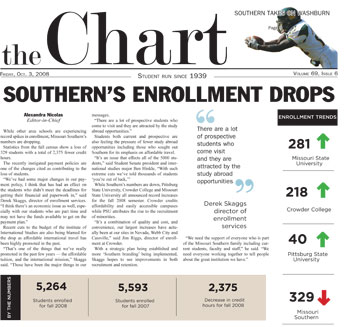‘Chart’ barred from college fair

'Southern's enrollment drops.'
Last week’s headline sparked controversy
[Editor’s note: We will continue to update this breaking story as the information becomes available.]
A University administrator prevented the display of The Chart, Missouri Southern’s campus newspaper, at a career fair Oct. 8th.
Derek Skaggs, director of enrollment services instructed a communication department representative not to display the paper because of a news story reporting a decline in enrollment.
“Well we’re out there trying to recruit students and I didn’t think it was appropriate to have a newspaper that’s talking about the decline in our enrollment,” Skaggs said.
University President Bruce Speck said that he would need more information to fully comment, but that college newspapers should have “wide latitude” in what they cover and how they are distributed.
“I don’t know the answer to that one, I’d have to find out where the limits of authority are in that type of situation,” Speck said.
Chart Editor-in-Chief, Alexandra Nicolas said the paper is concerned about the message this sends.
“We are concerned that accepting such an action without questions sets a dangerous precedent,” she said. “Not all news is good news.If it is accurate and fair it should not be suppressed.”
The Regional College Fair, held in Leggett & Platt Athletic Center hosted approximately 100 colleges, universities, technical and schools as well as military branches. In an e-mail sent out by Jack Oakes, assistant vice president for academic affairs, to faculty said fair was referred to as an “immediate opportunity” for recruiting with four tables reserved for Southern academic programs.
The Student Press Law Center told The Chart today that it believes the paper’s First Amendment rights were disregarded on Oct. 8 when the University administrator prevented the newspaper’s distribution at a college fair on campus.
“In my opinion I think your first amendment rights were definitely violated,” said Adam Goldstein, attorney advocate with the Student Press Law Center in Arlington, Va.
“The motivation is still a dislike of the content. I think that they can’t restrict the publication in the contact with the college fair, even thought they may, in the abstract, have a greater control over that event than others. So the First Amendment question is still going to be the exact same thing, did they have a content motivation and did it cause a detriment to the publication and in both cases the answer is yes.
“There may be 1,000 reasons why they could reject publication in this space, but one they can’t is that they don’t like what the publication says.
“It’s a little bit of a logical trap. The reason it’s a logical trap is it doesn’t matter how much control they have in the abstract it matters can they exert that control for this reason, and they can’t.”
Jean Maneke, legal consultant for the Missouri Press Association, also confirmed that objections to a student publication’s content are not grounds for the restriction of distribution.
“It’s clear that case law in this federal circuit supports that a university is limited in taking action against a student newspaper on the basis of its content,” she said.
Your donation will support the student journalists of Missouri Southern State University. Your contribution will allow us to purchase equipment and cover our annual website hosting costs.



























